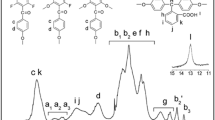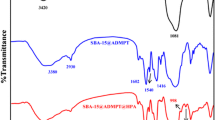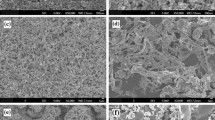Abstract
Titania/Hyperbranched polyglycidol (HBP) nanohybrids with tunable morphologies have been synthesized via a sol–gel process at ambient temperature. One-shot addition of varied amounts of titanium precursor tetraisopropoxide (TTIP) yields spherical titania/HBP solid particles with tunable size, while a controlled addition of TTIP results in spherical titania/HBP capsules. The average outer and inner diameters of the resultant capsules are also controllable according to the amount of TTIP via an Oswald ripening process. In addition, the modality of additional water supplied in the reaction systems can tune the morphologies of the resulting titania/HBP particles from nanocapsules to nanotubes owing to the accelerated hydrolysis rate of TTIP. The tunability in morphologies of the titania/HBP nanostructures ranging from solid spheres, capsules to tubes could be attributed to the self-assembly of a large amount of titania/HBP aggregates in a rapid, controlled and anisotropic manner, respectively. Surprisingly, by means of HBP contained in the resulting titania/HBP nanostructures, the gold nanoparticles are in situ generated and encapsulated into titania/HBP matrix in the absence of additional reducing agent. The as-prepared gold nanoparticles functionalized titania/HBP hybrids exhibit excellent catalytic function toward the reduction of 4-nitrophenol. This strategy demonstrates a typical example for functionalizing the titania/HBP hybrids targeted to specific applications.








Similar content being viewed by others
References
Buonsanti R, Grillo V, Carlino E, Giannini C, Curri ML, Innocenti C, Sangregorio C, Achterhold K, Parak FG, Agostiano A, Cozzoli PD (2006) Seeded growth of asymmetric binary nanocrystals made of a semiconductor TiO2 rodlike section and a magnetic γ-Fe2O3 spherical domain. J Am Chem Soc 128:16953–16970
Cao X, Gu L, Zhuge L, Gao W, Wang W, Wu S (2006) Template-free preparation of hollow Sb2S3 microspheres as supports for Ag nanoparticles and photocatalytic properties of the constructed metal-semiconductor nanostructures. Adv Funct Mater 16:896–902
Chen X, Mao SS (2007) Titanium dioxide nanomaterials: synthesis, properties, modifications, and applications. Chem Rev 107:2891–2959
Chen J, Qin G, Reveendran P, Ikushima Y (2006) Facile “green” synthesis, characterization, and catalytic function of β-d-glucose-stabilized Au nanocrystals. Chem Eur J 12:2131–2138
Cheng Y-J, Gutmann JS (2006) Morphology phase diagram of ultrathin anatase TiO2 films templated by a single PS-b-PEO block copolymer. J Am Chem Soc 128:4658–4674
Cheng Y-J, Müller-Buschbaum P, Gutmann JS (2007) Ultrathin anatase TiO2 films with stable vesicle morphology templated by PMMA-b-PEO. Small 3:1379–1382
Cozzoli PD, Kornowski, Weller H (2003) Low-temperature synthesis of soluble and processable organic-capped anatase TiO2 nanorods. J Am Chem Soc 125:14539–14548
Esumi K, Isono R, Yoshimura T (2004) Preparation of PAMAM- and PPI-metal (silver, platinum, and palladium) nanocomposites and their catalytic activities for reduction of 4-nitrophenol. Langmuir 20:237–243
Fievet F, Lagier JP, Figlarz M (1989) Preparing monodisperse metal powders in micrometer and submicrometer sizes by the polyol process. MRS Bull 14:29–34
Grätzel M (2001) Photoelectrochemical cells. Nature 414:338–344
Haag R, Stumb J-F, Sunder A, Frey H, Hebel A (2000) An approach to core–shell-type architectures in hyperbranched polyglycerols by selective chemical differentiation. Macromolecules 33:8158–8166
Hu Y, Ge J, Sun Y, Zhang T, Yin Y (2007) A self-templated approach to TiO2 microcapsules. Nano Lett 7:1832–1836
Huang J, Kunitake T (2006) Nanotubings of titania/polymer composite: template synthesis and nanoparticle inclusion. J Mater Chem 16:4257–4264
Jiang X, Herricks T, Xia Y (2003) Monodispersed spherical colloids titania: synthesis, characterization and crystallization. Adv Mater 15:1205–1209
Kainthan RK, Janzen J, Levin E, Devine DV, Brooks DE (2006) Biocompatibility testing of branched and linear polyglycidol. Biomacromolecules 7:703–709
Kainthan RK, Hester SR, Levin E, Devine DV, Brooks DE (2007) In vitro biological evaluation of high molecular weight hyperbranched polyglycerols. Biomaterials 28:4581–4590
Khan M, Huck WTS (2003) Hyperbranched polyglycidol on Si/SiO2 surfaces via surface-initiated polymerization. Macromolecules 36:5088–5093
Kim CW, Cha HG, Kim YH, Jadhav AP, Ji ES, Kang DI, Kang YS (2009) Surface investigation and magnetic behavior of Co nanoparticles prepared via a surfactant-mediated polyol process. J Phys Chem C 113:5081–5086
Komarneni S, Li D, Newalkar B, Katsuki H, Bhalla AS (2002) Microwave–polyol process for Pt and Ag nanoparticles. Langmuir 18:5959–5962
Kongkanand A, Tvrdy K, Takechi K, Kuno M, Kamat PV (2008) Quantum dot solar cells: tuning photoresponse through size and shape control of CdSe–TiO2 architecture. J Am Chem Soc 130:4007–4015
Krämer M, Pérignon N, Haag R, Marty J-D, Thomann R, Viguerie NL, Mingotaud C (2005) Water-soluble dendritic architectures with carbohydrate shells for the templation and stabilization of catalytically active metal nanoparticles. Macromolecules 38:8308–8315
Kurihara LK, Chow GM, Schoen PE (1995) Nanocrystalline metallic powders and films produced by the polyol method. Nanostruct Mater 5:607–613
Léaustic A, Bahonneau F, Livage J (1989) Structural investigation of the hydrolysis-condensation process of titanium alkoxides Ti(OR)4 (OR = OPr-iso, OEt) modified by acetylacetone. 2. From the modified precursor to the colloids. Chem Mater 1:248–252
Li J, Zeng HC (2007) Hollowing Sn-doped TiO2 nanospheres via ostwald ripening. J Am Chem Soc 129:15839–15847
Murakami Y, Matsumoto T, Takasu Y (1999) Salt catalysts containing basic anions and acidic cations for the sol–gel process of titanium alkoxide: controlling the kinetics and dimensionality of the resultant titanium oxide. J Phys Chem B 103:1836–1840
Qiu J, Yu W, Gao X, Li X (2007) Sol–gel assisted ZnO nanorod array template to synthesize TiO2 nanotube arrays. Nanotechnology 18: 295604 (5 pp)
Roberson LB, Poggi MA, Kowalik J, Smestad GP, Bottomley LA, Tolbert LM (2004) Correlation of morphology and device performance in inorganic–organic TiO2–polythiophene hybrid solid-state solar cells. Coord Chem Rev 248:1491–1499
Sewell SL, Rutledge RD, Wright DW (2008) Versatile biomimetic dendrimer templates used in the formation of TiO2 and GeO2. Dalton Trans 3857–3865
Sharma NC, Sahi SV, Nath S, Parsons JG, Gardea-Torresdey JL, Pal T (2007) Synthesis of plant-mediated gold nanoparticles and catalytic role of biomatrix-embedded nanomaterials. Environ Sci Technol 41:5137–5142
Shen Y, Kuang M, Shen Z, Nieberle J, Duan H, Frey H (2008) Gold nanoparticles coated with a thermosensitive hyperbranched polyelectrolyte: towards smart temperature and pH nanosensors. Angew Chem Int Ed 47:2227–2230
Song L, Lam YM, Boothroyd C, Teo PW (2007) One-step synthesis of titania nanoparticles from PS-P4VP diblock copolymer solution. Nanotechnology 18: 135605 (6 pp)
Stiriba S-E, Frey H, Haag R (2002) Dendritic polymers in biomedical applications: from potential to clinical use in diagnostics and therapy. Angew Chem Int Ed 41:1329–1334
Sugimoto T, Zhou X, Muramatsu A (2003) Synthesis of uniform anatase TiO2 nanoparticles by gel-sol method 4. Shape control. J Colloid Interface Sci 259:53–61
Sunder A, Hanselmann R, Frey H, Mülhaupt R (1999) Controlled synthesis of hyperbranched polyglycerols by ring-opening multibranching polymerization. Macromolecules 32:4240–4246
Wang Z-S, Kawauchi H, Kashima T, Arakawa H (2004) Significant influence of TiO2 photoelectrode morphology on the energy conversion efficiency of N719 dye-sensitized solar cell. Coord Chem Rev 248:1381–1389
Wei M, Konishi Y, Zhou H, Sugihara H, Arakawa H (2004) A simple method to synthesize nanowires titanium dioxide from layered titanate particles. Chem Phys Lett 400:231–234
Yin Y, Rious RM, Erdonmez CK, Hughes S, Somorjai GA, Alivisatos AP (2004) Formation of hollow nanocrystals through the nanoscale kirkendall effect. Science 304:711–714
Yin M, Cheng Y, Liu M, Gutmann JS, Müllen K (2008) Nanostructured TiO2 films templated by amphiphilic dendritic core–double–shell macromolecules: from isolated nanorings to continuous 2D mesoporous networks. Angew Chem Int Ed 47:8400–8403
Yu HK, Yi G-R, Kang J-H, Cho Y-S, Manoharan VN, Pine DJ, Yang S-M (2008) Surfactant-assisted synthesis of uniform titania microspheres and their clusters. Chem Mater 20:2704–2710
Zhang Y, Peng H, Huang W, Zhou Y, Zhang X, Yan D (2008) Hyperbranched poly(amidoamine) as the stabilizer and reductant to prepare colloid silver nanoparticles in situ and their antibacterial activity. J Phys Chem C 112:2330–2336
Zhou Y, Yan D (2009) Supramolecular self-assembly of amphiphilic hyperbranched polymers at all scales and dimensions: progress, characteristics and perspectives. Chem Commun 1172–1188
Acknowledgments
This study was supported by grants-in-aid for the World Class University Program (No. R32-2008-000-10174-0) and the National Core Research Center Program from MEST (No. R15-2006-022-01001-0), and the Brain Korea 21 program (BK-21).
Author information
Authors and Affiliations
Corresponding author
Rights and permissions
About this article
Cite this article
Li, H., Zhang, L., Jo, J.K. et al. Facile synthesis of titania/hyperbranched polyglycidol nanohybrids with controllable morphologies: from solid spheres, capsules to tubes. J Nanopart Res 13, 2117–2128 (2011). https://doi.org/10.1007/s11051-010-9969-3
Received:
Accepted:
Published:
Issue Date:
DOI: https://doi.org/10.1007/s11051-010-9969-3




